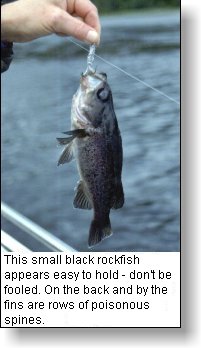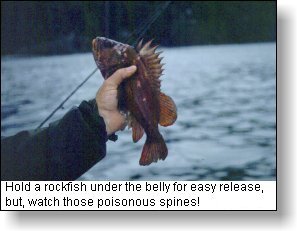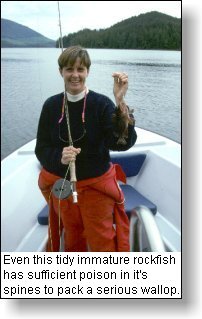
Saltwater Fly Fishing Series
"Scorpion Fishes - How to release these and other poisonous or sharptooth fishes"
with Barry M. Thornton
 Some years ago while salmon drift fishing in Johnstone
Strait, I hooked a small China rockfish, about four pounds, with
the Perkins lure I was using. This was not an uncommon experience but,
what happened next changed my whole approach to releasing bottomfish.
After bringing the rockfish to the boat I found that only one of the
treble hooks was caught in the fish's lip. In haste and frustration,
for I wanted to get my lure out in the water again for salmon, I picked
up the fish, by holding onto the lure, and gave the lure a vigorous
shake to dislodge the hook. It was a serious mistake! It seemed that
the fish shook and I shook at the same moment and the next thing I knew
the sharp poisonous dorsal spines had sunk into the fleshy palm of my
right hand. The pain was excruciating! I dropped on my knees in the
bottom of the boat and vomited over the side it was so intense. Then
I thrust my now bleeding hand in the cold waters and simply curled over
the gunnel as I waited for the pain to recede. It was a long fifteen
minutes before I could even speak coherently to my partner who was showing
deep concern. Later, while we drifted in a slow backeddy with the stimulant
of hot coffee, he told me I had turned chalky white from the obvious
shock the pain had inflicted on my system. It was a valuable lesson,
I had been careless and impatient, and, I was determined to find a better
way to release these poison spined fish.
 Rockfish
belong to the scientific fish family 'scorpaeidae', the Scorpion fishes,
a name which should be a warning in itself. As a species they are distinguished
by large broad heads and heavily-spined fins. They have a large mouth
and look like freshwater bass, but, don't try the 'bassmasters' lip
hold to free your hook. I tried this in my searching experiments and
found they have sharp fine teeth and a bony jaw, and, I required a number
of band-aides from the slashes on my thumb. Rockfish
belong to the scientific fish family 'scorpaeidae', the Scorpion fishes,
a name which should be a warning in itself. As a species they are distinguished
by large broad heads and heavily-spined fins. They have a large mouth
and look like freshwater bass, but, don't try the 'bassmasters' lip
hold to free your hook. I tried this in my searching experiments and
found they have sharp fine teeth and a bony jaw, and, I required a number
of band-aides from the slashes on my thumb.
Rockfish have spines - many many sharp poisonous spines! As a species
their single dorsal fin has between 11 and 17 long strong spines; the
anal fin has three strong spines; each other fin has one long spine;
and, the head has over 20 sharp short protruding spines. In all, the
rockfish is a formidable yet passive adversary for all predators.
The solution to a controlled release, I soon discovered, uses the natural
defensive posture of the fish. While not 'fail-safe', it now allows
me to quickly and safely release 9 of 10 rockfish hooked.
 When
a rockfish is threatened by a predator it erects its defensive spines
and assumes a rigid posture. Most predators, upon seeing the erect spines,
swim away for they know that it will be very difficult and dangerous
to swallow the rockfish as the stiff spines will puncture the throat
and stomach. As well, most predators are also allergic to the poisons
of the 'scorpion' fishes. When
a rockfish is threatened by a predator it erects its defensive spines
and assumes a rigid posture. Most predators, upon seeing the erect spines,
swim away for they know that it will be very difficult and dangerous
to swallow the rockfish as the stiff spines will puncture the throat
and stomach. As well, most predators are also allergic to the poisons
of the 'scorpion' fishes.
When an angler touches a hooked rockfish it will instinctively assume
a rigid posture with erect spines. Once it has taken this rigid stance
I hold the rockfish is the one area that it does not have spines, the
belly. As the photo shows; using a FIRM grip, hold the rockfish on the
belly, fingers under (or, holding down) the pectoral fin. You will be
amazed at how easy and safe it is to then release your hook with pliers.
I recommend pliers simply because it is quicker.
Bottomfish on the Pacific coast include a vast variety of ocean fishes.
The most common on the west coast are the rockfish which number 36 distinct
species. Bottomfish include everything from staghorn sculpins (small
bullheads) to cabezon (giant bullheads some weighing up to twenty pounds),
and, from ling cod and greenling, to the various flatfish like Pacific
halibut and soles. All have varying methods of defense whether it
be coloration or body armour. Except for the scorpion fishes few have
any mechanism (except teeth) that can be called dangerous.
 While
the dogfish can not be called a bottomfish they too are difficult to
unhook and release. Dogfish have rigid dangerous spines in front of
their two dorsal fins - hence their name "Spiny Dogfish". In many cases,
particularly when drift fishing, dogfish are snagged rather than hooked
in the mouth. I have been fortunate (?) to have hooked thousands of
dogfish while drift fishing and have even targeted these fish with my
flies with much success on a slooowww retrieve. I now use the following
simple release technique. I will play the mudshark out, then, grab it
by the tail and hold it high so I can use my pliers to take out the
hook. While the dogfish may twist when it is held up, it is powerless
to use the dorsal spines, or, it's mouth. Another solution I often use
is to change my treble hooks to single hooks when I am fishing waters
with dogfish. The single hook rarely snags dogfish while drift fishing,
and, if it does, I simply cut my leader below my lure or, cut the hook
ring with my pliers, leaving the hook on the fish to rust and fall away. While
the dogfish can not be called a bottomfish they too are difficult to
unhook and release. Dogfish have rigid dangerous spines in front of
their two dorsal fins - hence their name "Spiny Dogfish". In many cases,
particularly when drift fishing, dogfish are snagged rather than hooked
in the mouth. I have been fortunate (?) to have hooked thousands of
dogfish while drift fishing and have even targeted these fish with my
flies with much success on a slooowww retrieve. I now use the following
simple release technique. I will play the mudshark out, then, grab it
by the tail and hold it high so I can use my pliers to take out the
hook. While the dogfish may twist when it is held up, it is powerless
to use the dorsal spines, or, it's mouth. Another solution I often use
is to change my treble hooks to single hooks when I am fishing waters
with dogfish. The single hook rarely snags dogfish while drift fishing,
and, if it does, I simply cut my leader below my lure or, cut the hook
ring with my pliers, leaving the hook on the fish to rust and fall away.
We are most fortunate to have a vast variety of Pacific ocean fishes
in our British Columbia waters. They can provide some exciting fishing
and need only be handled carefully and firmly to be released.
"The End"
© Copyright Barry M. Thornton
Barry M. Thornton
| 




 Rockfish
belong to the scientific fish family 'scorpaeidae', the Scorpion fishes,
a name which should be a warning in itself. As a species they are distinguished
by large broad heads and heavily-spined fins. They have a large mouth
and look like freshwater bass, but, don't try the 'bassmasters' lip
hold to free your hook. I tried this in my searching experiments and
found they have sharp fine teeth and a bony jaw, and, I required a number
of band-aides from the slashes on my thumb.
Rockfish
belong to the scientific fish family 'scorpaeidae', the Scorpion fishes,
a name which should be a warning in itself. As a species they are distinguished
by large broad heads and heavily-spined fins. They have a large mouth
and look like freshwater bass, but, don't try the 'bassmasters' lip
hold to free your hook. I tried this in my searching experiments and
found they have sharp fine teeth and a bony jaw, and, I required a number
of band-aides from the slashes on my thumb. When
a rockfish is threatened by a predator it erects its defensive spines
and assumes a rigid posture. Most predators, upon seeing the erect spines,
swim away for they know that it will be very difficult and dangerous
to swallow the rockfish as the stiff spines will puncture the throat
and stomach. As well, most predators are also allergic to the poisons
of the 'scorpion' fishes.
When
a rockfish is threatened by a predator it erects its defensive spines
and assumes a rigid posture. Most predators, upon seeing the erect spines,
swim away for they know that it will be very difficult and dangerous
to swallow the rockfish as the stiff spines will puncture the throat
and stomach. As well, most predators are also allergic to the poisons
of the 'scorpion' fishes. While
the dogfish can not be called a bottomfish they too are difficult to
unhook and release. Dogfish have rigid dangerous spines in front of
their two dorsal fins - hence their name "Spiny Dogfish". In many cases,
particularly when drift fishing, dogfish are snagged rather than hooked
in the mouth. I have been fortunate (?) to have hooked thousands of
dogfish while drift fishing and have even targeted these fish with my
flies with much success on a slooowww retrieve. I now use the following
simple release technique. I will play the mudshark out, then, grab it
by the tail and hold it high so I can use my pliers to take out the
hook. While the dogfish may twist when it is held up, it is powerless
to use the dorsal spines, or, it's mouth. Another solution I often use
is to change my treble hooks to single hooks when I am fishing waters
with dogfish. The single hook rarely snags dogfish while drift fishing,
and, if it does, I simply cut my leader below my lure or, cut the hook
ring with my pliers, leaving the hook on the fish to rust and fall away.
While
the dogfish can not be called a bottomfish they too are difficult to
unhook and release. Dogfish have rigid dangerous spines in front of
their two dorsal fins - hence their name "Spiny Dogfish". In many cases,
particularly when drift fishing, dogfish are snagged rather than hooked
in the mouth. I have been fortunate (?) to have hooked thousands of
dogfish while drift fishing and have even targeted these fish with my
flies with much success on a slooowww retrieve. I now use the following
simple release technique. I will play the mudshark out, then, grab it
by the tail and hold it high so I can use my pliers to take out the
hook. While the dogfish may twist when it is held up, it is powerless
to use the dorsal spines, or, it's mouth. Another solution I often use
is to change my treble hooks to single hooks when I am fishing waters
with dogfish. The single hook rarely snags dogfish while drift fishing,
and, if it does, I simply cut my leader below my lure or, cut the hook
ring with my pliers, leaving the hook on the fish to rust and fall away.